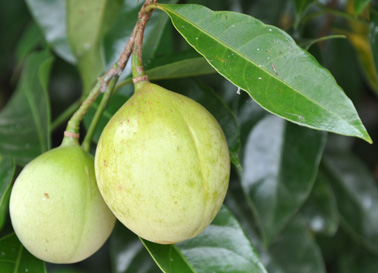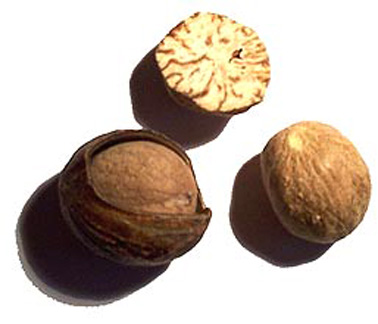|
Botanical Name:
Myristica fragrans Houtt.
Jaiphal consists of the endosperm of dried seeds (kernels of
fruits) of Myristica fragrans Houtt, Family Myristicaceae
Common Name(s) in English & Indian Languages
Sanskrit: Jatisasya, Jatiphala
Assamese: Jaiphal, Kanivish
Bengali: Jaiphala, Jaitri
English: Nutmeg
Guajarati: Jaiphala, Jayfar
Hindi: Jaiphal
Kannada: Jadikai, Jaykai, Jaidikai
Kashmiri: Jafal
Malayalam: Jatika
Marathi: Jaiphal
Oriya: Jaiphal
Punjabi: Jaiphal
Tamil: Sathikkai, Jathikkai, Jatikkai, Jadhikai, Jadhikkai
Telugu: Jajikaya
Urdu: Jauzbuwa, Jaiphal
Botanical description:
Myristica fragrans Houtt., commonly known as Jaiphal and
Javitri in India. It produces two spices, nutmeg and mace.
Nutmeg is the seed kernel inside the fruit and mace is the
fleshy red, net like skin covering (aril) on the kernel. It
is a spreading aromatic evergreen tree usually growing to 5
to 13 metres high, occasionally 20 metres. The pointed dark
green leaves are arranged alternately along the branches and
are borne on leaf stems about 1 cm long. Upper leaf surfaces
are shiny. Flowers are usually single sexed; occasionally
male and female flowers are found on the same tree. Female
flowers arise in groups of 1 to 3; males in groups of 1 to
10. Flowers are pale yellow, waxy, fleshy and bell-shaped.
The fruits are fleshy, drooping, yellow, smooth, 6 to 9 cm
long with a longitudinal ridge. When ripe, the succulent
yellow fruit coat splits into 2 valves revealing a
purplish-brown, shiny seed (nutmeg) surrounded by a red aril
(mace). Seeds (nutmegs) are broadly ovoid (2 to 3 cm long),
firm, fleshy, whitish and transversed by red-brown veins.
When fresh, the aril (mace) is bright scarlet becoming more
horny, brittle and a yellowish-brown color when dried. The
trees do not give flowers until around 9 years old, but once
start flowering they continue to do so for further 75 years.
The trees bear 2 to 3 crops a year. The seeds (nutmegs) need
3 to 6 weeks to dry before they are ready for use
Parts used:
Fruits
Major chemical constituent:
Essential oil and fixed oil.
Therapeutic uses:
• Diarrohoea (Atisara)
• Asthma (Svasa)
• Emesis (Chardi)
• Cough (Kasa)
• Sinusitis (Pinasa)
• Malabsorption syndrome (Grahani)
• Disease of mouth (Mukharoga)
• Spermatorrhoea (Sukrameha) |
|


|
|
|



